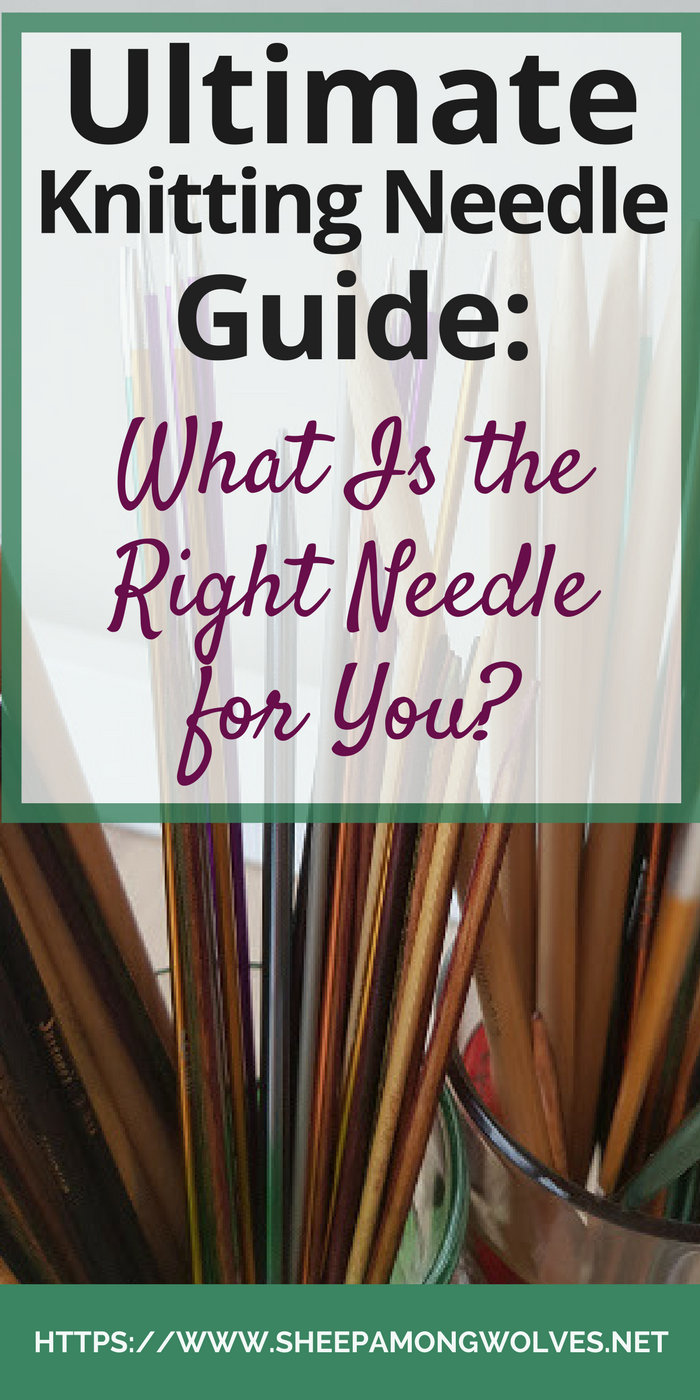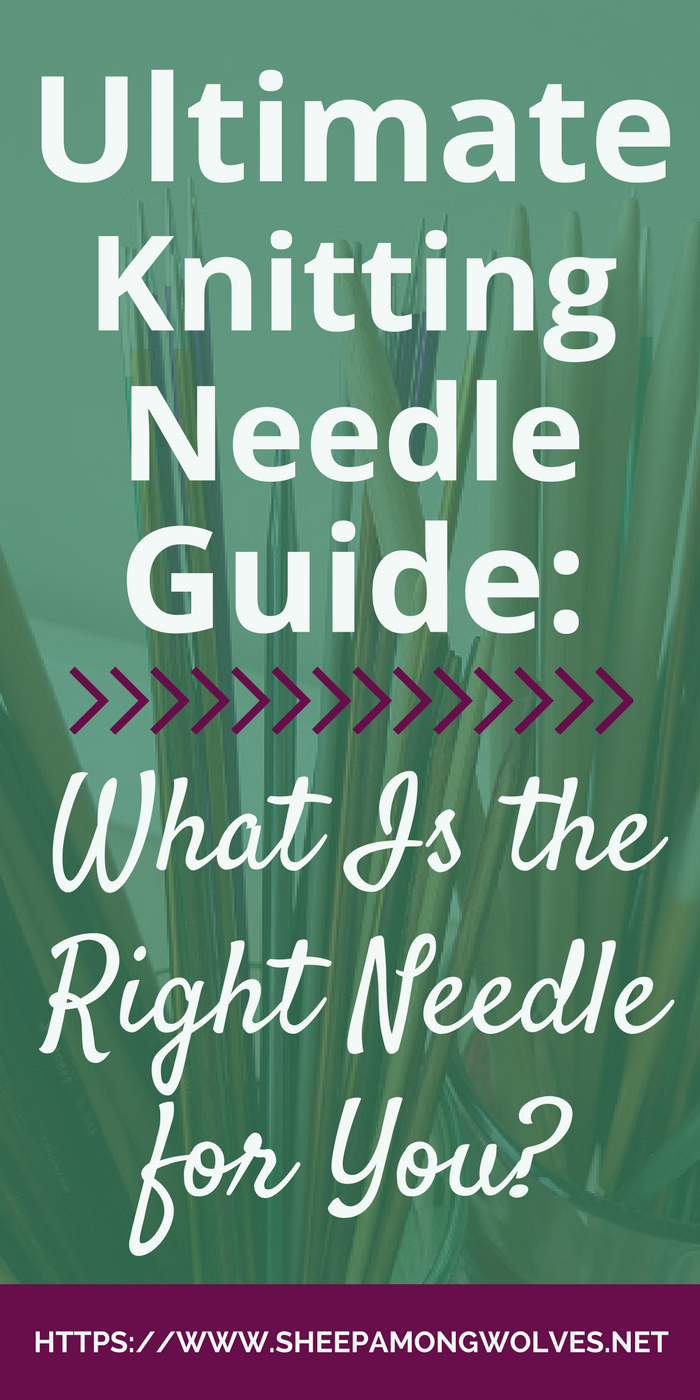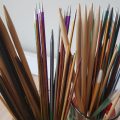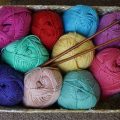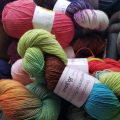There are tons of knitting needles out there. All kinds of sizes and shapes, materials, and lengths. As it is with many things, the “right” knitting needle is (in part) a matter of preference. How would a beginner know which needles to choose then? You can ask someone who can give you advise. The wonderful people at your nearest LYS can help. But if you want some information about knitting needles now that might help you with your choice, then here is a quick guide to knitting needles.
Straights or Single Pointed Needles
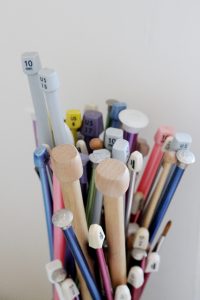
Straight needles / single pointed needles
These are usually long (I’ve seen them in lengths between 25cm/10 inches and 40cm/roughly 16 inches) and straight – hence the name. They have a stopper at one end and a tip at the other.
These needles can be used for anything worked flat like afghans, shawls, scarfs, flat knit cardigans and sweaters. They are also often used or preferred by lever knitters.
Straights can get heavy when knitting larger projects. And their length and weight can be troublesome for all non-lever knitters because they move the needles more while knitting. This can put stress on your wrists, hands, and arms and tire you out. If you are prone to repetitive stress injuries or carpal tunnel syndrome, you may want to be careful with these needles. I have weak joints and can injure them very easily. I did give straights a try but found that I couldn’t use them without causing me pain.
There are also a few flexible straights out there. These are shorter needles of about 10 to 12 cm or 4 to 5 inches. They have a cable attached to them with a stopper at the end. You can build your own flexible straights with a set of interchangeable needles. I’ve never used these myself, but I would imagine that they are more comfortable on the joints than regular straights.
- KnitPro Zing Single Pointed Needles (*)
- Addi Bamboo Single Pointed Needles (*)
- KnitPro Simfonie Wood Single Pointed Needles
- Signature Needle Arts Single Pointed Needles
Circulars
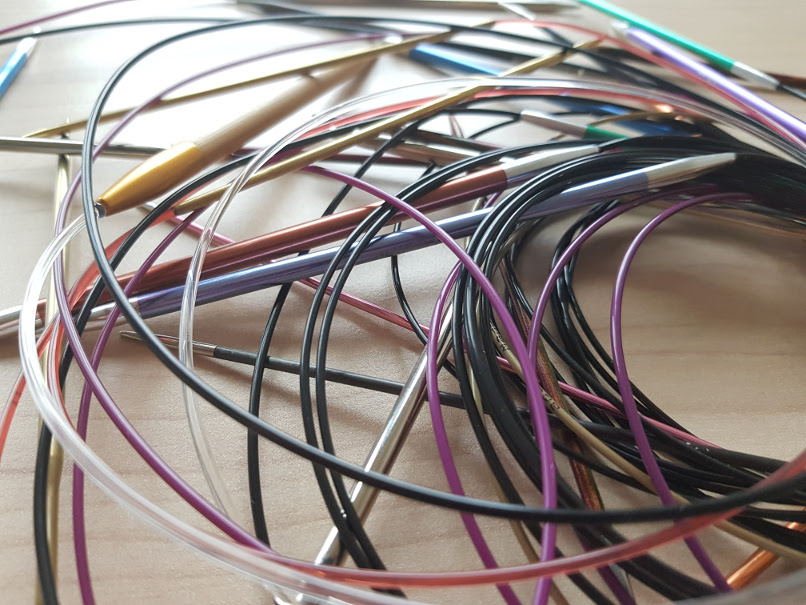
A small selection of my circular needles
I find these to be the most versatile needles. You can knit pieces of any size flat with them. And once you learned how to knit magic loop you can also knit any diameter in the round with them. It may take a little getting used to and can be a bit fiddly at first with the cable looping around like that. But it was well worth it for me. I’m much quicker at knitting even a small diameter on circulars than I was with double pointed needles. On top of that, I find them easy on my joints and very comfortable to knit with even for long stretches. They are usually lighter than straights.
They are great for traveling. The needles are short and the cable flexible, so they are easy to pack. And if you already have a project on the needles you don’t need to worry about stitches falling off because you can just slide the project onto the cable entirely and have the needles dangling down. (Unless you have too many stitches on the needles then you might still have to invest in stoppers.) Circulars are also the needles that are most likely to be allowed on a plane.
You may find that will need multiple needles of the same size if you knit a lot with circulars – and not only because the others are still occupied by WIPs. You may need different cable lengths for other projects. I use 80-100 cm (31.5 – 39 inches) lengths the most.
- KnitPro Trendz Fixed Circular Needles (*)
- ChiaoGoo Red Lace Stainless Steel Fixed Circular Needles (*)
- Addi Olivewood Circular Needles (*)
Double Pointed
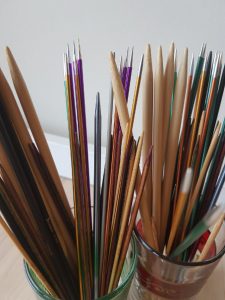
Double pointed needles
Double pointed needles are good at two things: knitting a small diameter in the round and knitting tiny things (knitted edges or I-cord, e.g.). Anything with only a few stitches at once. They also double nicely as cable needles and are great for fixing mistakes in your knitting (when you are dropping stitches a few rows and knit them back up). So it is a good idea to have at least some of them around.
For inexperienced knitters, knitting with double pointed needles can be tricky. Having so many needles at once in your project can take some getting used to. And many of us get ladders between the needles when we’re starting out. They form due to excess yarn. What you need to do to avoid them is tighten the first and last stitch on each needle which pulls these stitches closer together. If the first stitch of your needle is a knit stitch keep the right-hand needle below the last needle when knitting it and pull a bit on the yarn to tighten up the stitch. If the first stitch is purl a stitch your right-hand needle needs to be held above the previous needle.
- KnitPro Double Pointed Needles
- Knitter’s Pride Royale Double Pointed Needles (*)
- HiyaHiya Bamboo Double Pointed Needles (*)
Addi CraSy Trio/CrazyTrio
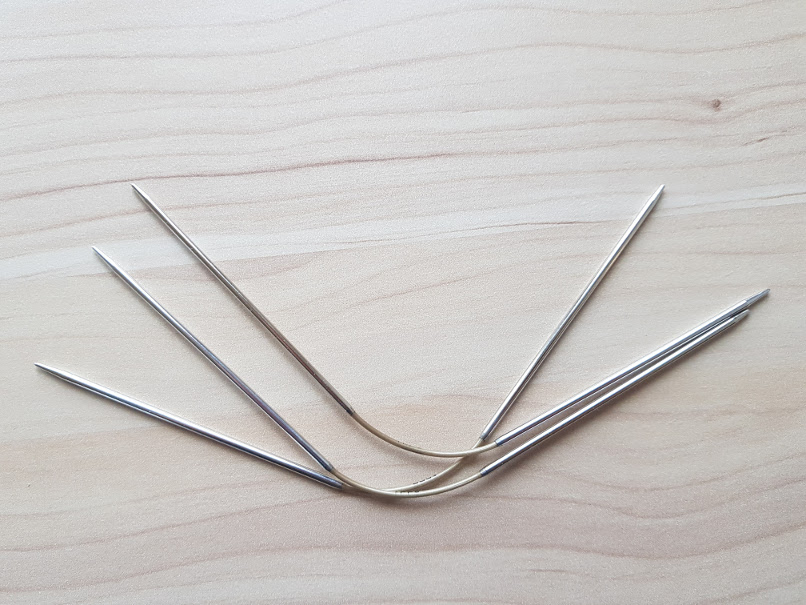
Addi CraSy Trio / CrazyTrio
These are pretty new. They were created especially for knitting small diameter like socks. You get three needles, and they are technically circulars but with a very short cable. So it’s like knitting socks on circulars only without the magic loop.
I have a set, but I haven’t tried them yet. I will knit a pair of socks with them to see what it feels like and then post a review about them.
- Addi CrazyTrio (amazon.com) (*)
- Addi CraSy Trio (amazon.de) (*) or Addi CraSy Trio (amazon.co.uk) (*) (more sizes are available here than on amazon.com)
Interchangeable Needle Sets
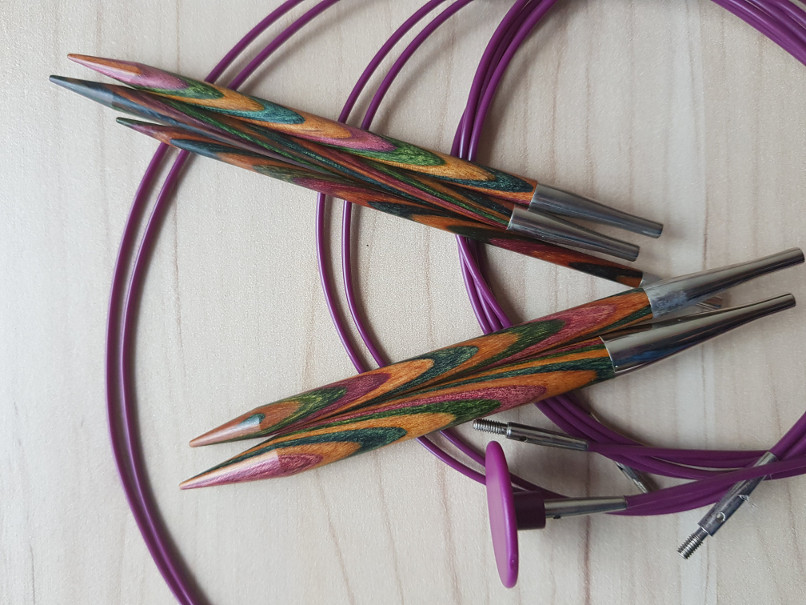
Interchangeable needles
These are great for people who use a lot of circulars. These sets include a couple of cables and needle tips in various sizes (and usually stoppers and a tool to help you take needle tips off of cables again). You can build your own cable needle with it just put the needle tip of the correct size onto the cable of the length you want, and you’re good to go. You can also quickly switch needles tips while knitting should you need to do that, so you don’t have to go looking for another circular. And the cable can double as a big stitch holder if you exchange the needle tips for stoppers.
The place where needle tip and cable join can snag a little, though. That can be quite annoying when you are a tight knitter.
If a set does not include all the needle sizes and cables you need, it is always possible to buy needle tips or cables separately. They should be available for purchase where you bought your set. That means of course that it is also possible to start with only a few needle tips and cables and not buy a complete set.
- HiyaHiya Bamboo Standard Interchangeable Needle Set (*)
- ChiaoGoo Twist Stainless Steel Lace Interchangables (*)
- KnitPro Trendz Interchangeable Needle Set (*)
- KnitPro Karbonz Special Interchangeable Needle Tips (1 pair) (*)
- Signature Needle Arts Convertible Set
Square Needles
Instead of round needles, you can buy them in a square shape as well. These are supposed to make stitches more even and are supposedly very comfortable in handling. I haven’t used them myself, so I can’t say if this is true or not.
Special Needles
Now, these aren’t the only needle types we knitters use. There are still those that fall into the accessories category.
Cable Needles
These are special small needles made to help you cross stitches for cables. They are usually a bit curvy, so you don’t have to hold them all the time but can just let them hang while they have stitches on them. You slip the stitches that need to switch places with the next stitches onto the cable needle and let them either hang before or behind your work, depending on which way the cable twists. Then you knit the next stitches and then the stitches from the cable needle. Very easy to use.
I rarely use them now, only when I need to twist more than four stitches at once. After I learned how to knit cables without the cable needle, I got a lot faster. That’s also why I can’t tell you where my set of cable needles is right now and I just needed to buy a new one. I usually use double points instead but if you need to do a lot of cables a cable needle is simpler because it can’t slip out of the stitches that easily.
- Clover U-Shaped Cable Needles (*)
- KnitPro Aluminium Cable Needles (*)
- Knitter’s Pride Symfonie Wood Dreamz Cable Needles (these are straight) (*)

Stitch holders and cable needles
Stitch Holders
Whenever you need to hold live stitches for later, these are great to use. You could also put the stitches on a piece of waste yarn, but stitch holders are often simpler because you can just knit directly off of them.
My favorites are the ones from Clover. They are made of flexible plastic, light and the best thing is that you can knit off of them from both ends (follow the link below to see what I mean).
Which is your favorite needle type? Or do you use them all? Have you tried them all before? Please let me know in the comments below.
Affiliate disclaimer: This post contains affiliate links (links marked by (*)). That means that at no extra cost to you I will receive a small compensation should you choose to purchase after clicking on such a link. Please, read this for more details.
Next week we talk about material, how it can affect your knitting experience and which material might be right for you. And then I will also tell you about some of the needles I’ve used and which ones are my favorites now. So check back next week for more!
Did you enjoy this post? Then please share it on Pinterest!
